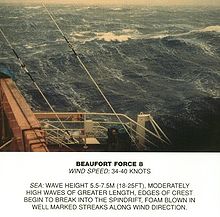Spindrift: Difference between revisions
Tom.Reding (talk | contribs) m →References: Rem stub tag(s) (class = non-stub & non-list) using AWB |
added link to sea spray |
||
| Line 2: | Line 2: | ||
[[Image:Beaufort scale 8.jpg|thumb|Spindrift on stormy sea]] |
[[Image:Beaufort scale 8.jpg|thumb|Spindrift on stormy sea]] |
||
'''Spindrift''' usually refers to spray, particularly to the spray blown from cresting waves during a [[gale]]. This spray, which "drifts" in the direction of the gale, is one of the characteristics of a wind speed of 8 [[Beaufort scale|Beaufort]] and higher at sea. |
'''Spindrift''' usually refers to [[Sea spray|spray]], particularly to the spray blown from cresting waves during a [[gale]]. This spray, which "drifts" in the direction of the gale, is one of the characteristics of a wind speed of 8 [[Beaufort scale|Beaufort]] and higher at sea. |
||
In Great Britain "spindrift" is the telltale sign used by mariners to define a Force 8 (Beaufort Scale) wind (not higher) when observed at sea. See this example of information provided by Lymington Harbour authority, Hampshire, England, UK, explaining the whole scale, the associated wind speeds, and its telltale signs. Text from the site<ref>http://www.lymingtonharbour.co.uk/tide%20weather/tide%20weather.htm</ref> states: |
In Great Britain "spindrift" is the telltale sign used by mariners to define a Force 8 (Beaufort Scale) wind (not higher) when observed at sea. See this example of information provided by Lymington Harbour authority, Hampshire, England, UK, explaining the whole scale, the associated wind speeds, and its telltale signs. Text from the site<ref>http://www.lymingtonharbour.co.uk/tide%20weather/tide%20weather.htm</ref> states: |
||
Revision as of 07:44, 2 October 2016

Spindrift usually refers to spray, particularly to the spray blown from cresting waves during a gale. This spray, which "drifts" in the direction of the gale, is one of the characteristics of a wind speed of 8 Beaufort and higher at sea.
In Great Britain "spindrift" is the telltale sign used by mariners to define a Force 8 (Beaufort Scale) wind (not higher) when observed at sea. See this example of information provided by Lymington Harbour authority, Hampshire, England, UK, explaining the whole scale, the associated wind speeds, and its telltale signs. Text from the site[1] states:
Force 8, defined as "Gale". Wind speed 39-46 mph, equal to 34-40 knots. Inland, twigs break off trees; progress generally impeded. At sea, moderately high waves of greater length; edges of crests begin to break into spindrift; foam is blown in well-marked streaks along the direction of the wind.
Relatedly, spindrift can also be used to describe fine sand or snow that is blown off by the wind.[2]
Spindrift is a southern English word, Spoondrift a northern or Scottish word. The Scottish word spoondrift can be used to describe fine snow that is blown off the hills by the wind.
Some sources[3] regard "spoondrift" as a direct alternative to "spindrift" in all its uses.
In Greek and Roman mythology, Leucothea is considered the goddess of spindrift.[4]
References
- ^ http://www.lymingtonharbour.co.uk/tide%20weather/tide%20weather.htm
- ^ Spindrift entry on Merriam Webster. Retrieved 20 July 2008.
- ^ http://www.crosswordsolver.org/definition/S/spoondrift
- ^ See footnote 117 in Marcel Proust, In the Shadow of Young Girls in Flower, trans. James Grieve (New York: Penguin Books, 2002).
